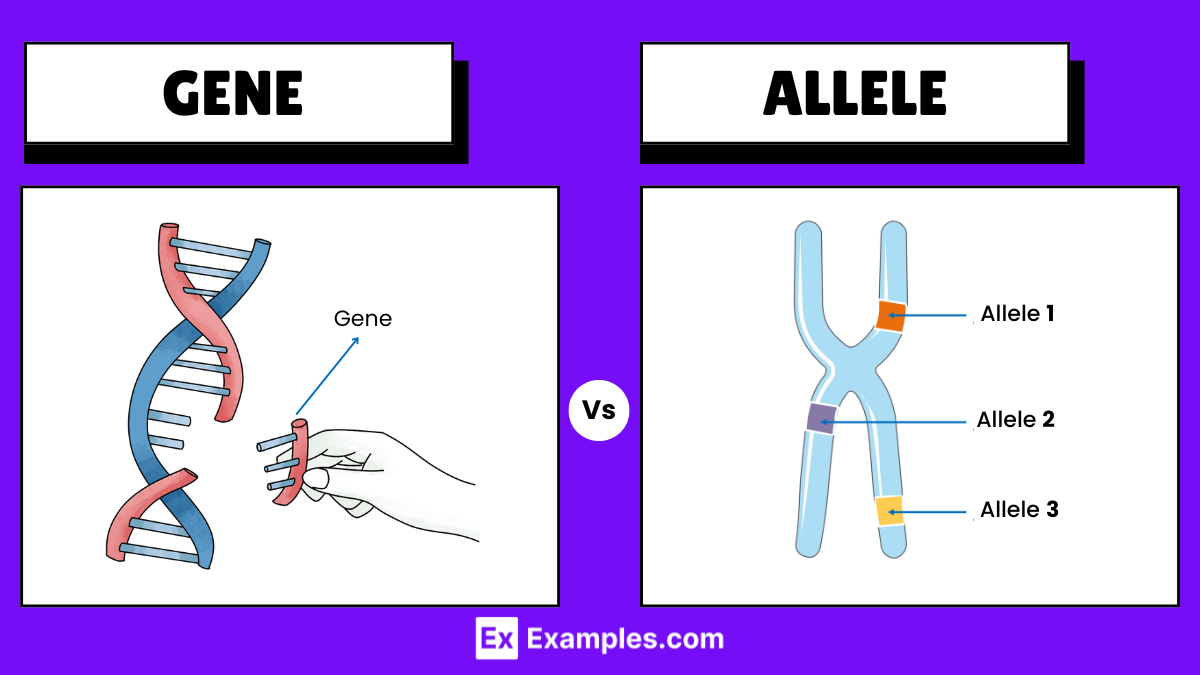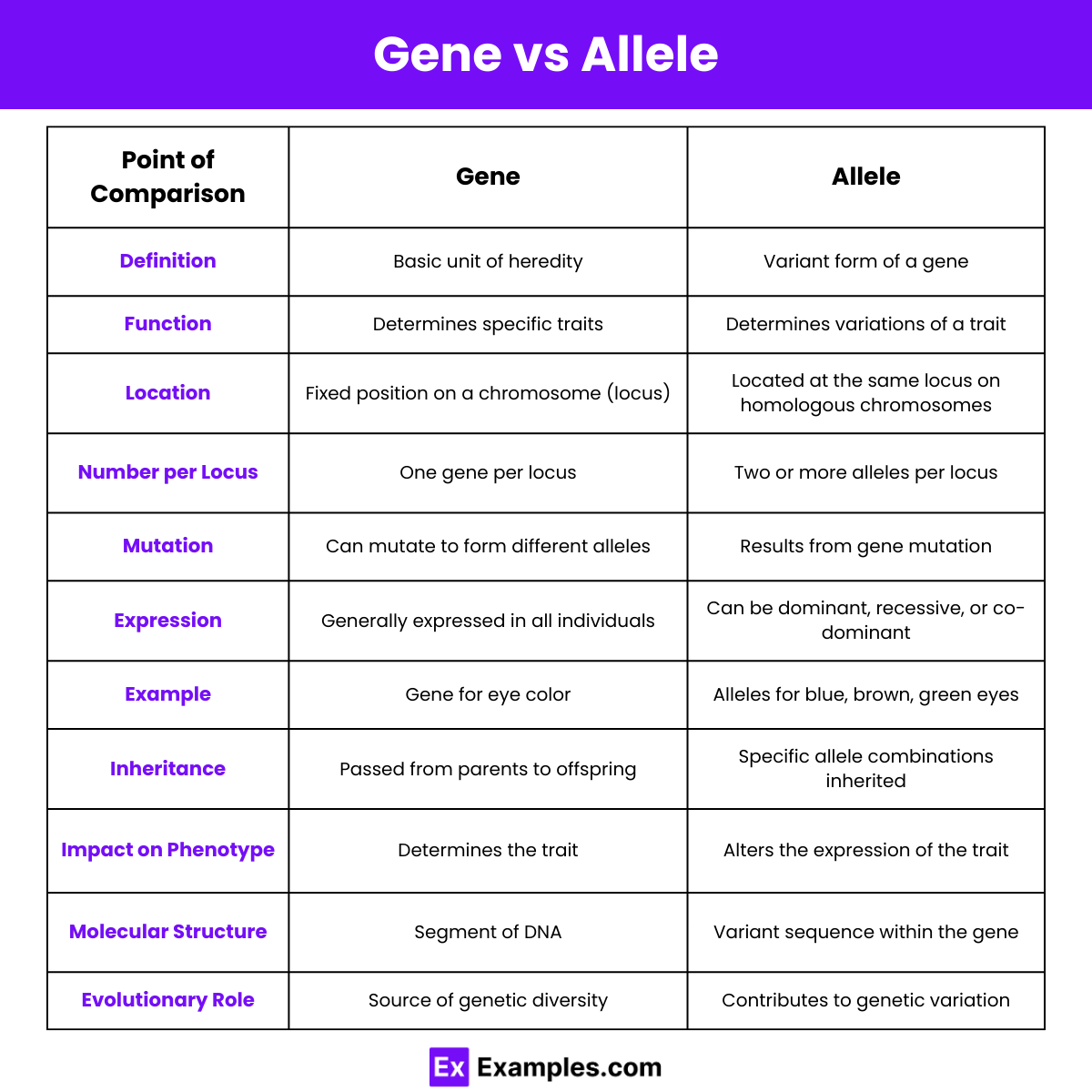What is the primary function of a gene?
To code for a protein
To provide energy to cells
To repair cellular damage
To produce energy


In genetics, understanding the difference between a gene and an allele is crucial. Genes are segments of DNA that code for proteins, which determine traits. Alleles are different versions of a gene that arise through mutation and contribute to genetic diversity. By exploring how genes and alleles work, we can better grasp heredity, variation, and evolution. This article delves into the fundamental distinctions between genes and alleles, providing clear explanations and examples to help you understand their roles in biology.
A gene is a fundamental unit of heredity in living organisms. Genes consist of DNA and are responsible for coding the instructions for building and maintaining cells and passing genetic information from one generation to the next.
Gene expression is the process by which the information encoded in a gene is used to direct the synthesis of a protein. This involves:
An allele is a variant form of a gene that arises by mutation and is found at a specific place on a chromosome. Alleles contribute to the genetic diversity within a population by introducing variations in traits. Here’s an in-depth look at alleles:

| Feature | Gene | Allele |
|---|---|---|
| Definition | A segment of DNA that contains the instructions for the development of a specific trait or function. | A variant form of a gene that arises by mutation and is found at the same place on a chromosome. |
| Function | Codes for proteins and determines various biological functions and traits. | Influences the specific expression of a trait or characteristic. |
| Number per Trait | Typically, one gene per trait, though some traits are influenced by multiple genes (polygenic). | Multiple alleles can exist for a single gene, but an individual can have only two alleles (one from each parent) for a given gene. |
| Example | The gene for eye color. | The alleles for eye color could be blue, brown, green, etc. |
| Nucleotide Sequence | Comprises a long sequence of DNA that includes coding regions (exons) and non-coding regions (introns). | Slight differences in the nucleotide sequence of a gene that create different alleles. |
| Inheritance | Genes are inherited from parents to offspring and determine the general structure and function. | Alleles are the specific variations of a gene inherited from each parent. |
| Expression | Genes are generally expressed to produce RNA and proteins, leading to phenotypic traits. | Alleles determine the variations in the expression of the gene, leading to different phenotypes. |
| Location on Chromosome | A specific locus (position) on a chromosome. | Found at the same locus on homologous chromosomes, but may differ in sequence between the two homologues. |
| Impact on Phenotype | The overall gene influences the phenotype related to a particular trait. | Different alleles can result in variations in the phenotype, such as different eye colors, blood types, or risk of certain diseases. |
| Mutation | Gene mutations can create new alleles. | Alleles are essentially versions of a gene created through mutation. |
A gene is a DNA segment that codes for a specific protein or function, acting as a fundamental unit of heredity.
An allele is a variant form of a gene that determines specific traits or characteristics.
Genes are DNA segments responsible for traits; alleles are variations of these genes causing different expressions of a trait.
Yes, a gene can have multiple alleles, each producing different trait variations.
Eye color is determined by the gene OCA2, with alleles producing blue, green, or brown eyes.
Genes are inherited from parents, with one copy from each parent forming pairs in offspring.
Alleles determine the variations in traits inherited from each parent, leading to genetic diversity.
Yes, alleles can be dominant (expressed trait) or recessive (masked by dominant allele).
Homozygous alleles occur when an individual has two identical alleles for a trait.
Heterozygous alleles occur when an individual has two different alleles for a trait.
Text prompt
Add Tone
10 Examples of Public speaking
20 Examples of Gas lighting
What is the primary function of a gene?
To code for a protein
To provide energy to cells
To repair cellular damage
To produce energy
What distinguishes an allele from a gene?
Alleles are different versions of the same gene
Alleles are found in different chromosomes
Genes determine the physical traits directly
Genes are not related to traits
How many alleles do individuals inherit for each gene?
One
Two
Three
Four
Which term refers to the physical expression of a gene?
Genotype
Phenotype
Allele
Locus
If a gene has two alleles, one dominant and one recessive, which allele determines the trait if both are present?
Recessive allele
Dominant allele
Both alleles
Neither allele
Which of the following represents the genetic makeup of an individual?
Phenotype
Genotype
Allele
Trait
How do alleles contribute to genetic diversity?
By providing the same genetic code to all organisms
By creating different versions of genes
By deleting genes from the genome
By preventing mutations
What is the role of a recessive allele in the presence of a dominant allele?
It always determines the trait
It only expresses itself if the dominant allele is absent
It changes the dominant allele
It suppresses the dominant allele
Which of the following pairs of alleles represents a homozygous genotype?
AA
Aa
Bb
AB
What term describes the location of a gene on a chromosome?
Allele
Locus
Phenotype
Genotype
Before you leave, take our quick quiz to enhance your learning!

